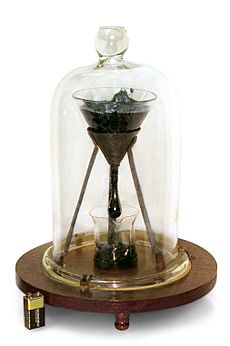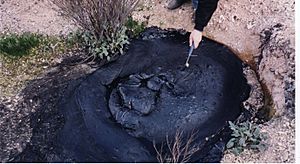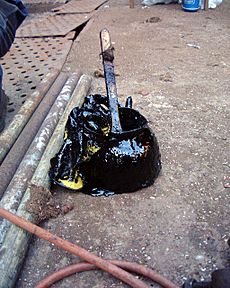Pitch (resin) facts for kids
Pitch is a super sticky, gooey substance. It can be found naturally or made by people. It comes from things like petroleum (which is used to make gasoline), coal tar, or even plants. You might also hear pitch called tar, bitumen, or asphalt. When pitch comes from plants, it's often called resin. Some products made from plant resin are also known as rosin.
How People Use Pitch
For a long time, people have used pitch for many things. One common use was to help seal the gaps in wooden sailing ships. This stopped water from getting in! It was also used to coat clay pots to keep wine fresh.
Pitch is great for making things waterproof, like wooden buckets. It was even used to make torches. The pitch that comes from petroleum is very dark, which is why we say something is "pitch-black" when it's super dark.
Pitch is also used to polish special lenses and mirrors. Think of the lenses in telescopes or cameras! Pitch can slowly change its shape, which helps it stay in perfect contact with the surface being polished. This makes the lenses super smooth and clear.
There's also a special type called Chasers pitch. It's a mix of pitch and other things, used by jewelers when they are making beautiful jewelry.
The Amazing Slow Flow of Pitch

Pitch might look like a solid, but it's actually a very, very slow-moving liquid. Scientists call this a "viscoelastic polymer." This means it can break if you hit it hard, but it will also slowly flow over time, just like a super thick syrup.
One of the most famous examples of this is the pitch drop experiment at the University of Queensland in Australia. This experiment has been running for many, many years! In 1930, some pitch was put into a glass funnel. Since then, it has been slowly dripping out.
- Only nine drops have fallen since 1930.
- The eighth drop fell in November 2000.
- The ninth drop fell in April 2014.
Scientists figured out that the pitch in this experiment is about 230 billion times thicker than water! That's incredibly slow.
Another similar experiment started in 1944 at Trinity College, Dublin in Ireland. For the first time ever, scientists there caught a drop of pitch falling on camera in July 2013!
There's even a "pitch glacier" demonstration at Winchester College in England. It has been running since 1906!
How Pitch is Made
One way to make pitch is by heating wood without much air, a process called "dry distilling." When you do this, tar and pitch drip out of the wood, leaving behind charcoal.
- Birch-tar: A very good type of tar is made from birchbark.
- Tar vs. Pitch: People often use the words tar and pitch to mean the same thing. But generally, pitch is more solid, while tar is more liquid.
Traditionally, the pitch used for waterproofing things like barrels and small boats came from pine trees. It's also used to make something called Cutler's resin.
Long ago, people had special ways to prepare pitch. An old Greek book from the 10th century describes how they used pitch for ceramic wine casks: They would put wood-based pitch in a clay pot and heat it gently in the sun. Then, they would pour hot water (that had been filtered through wood-ashes) onto it and stir. After a couple of hours, they would pour it out and add more water. They did this three times a day for three days. This made the pitch very good for use.
They would apply the pitch to the ceramic pots right after they came out of the hot oven, both inside and out.
See also
 In Spanish: Alquitrán para niños
In Spanish: Alquitrán para niños
- Asphaltene
- Creosote
- Pine tar
- Tar



